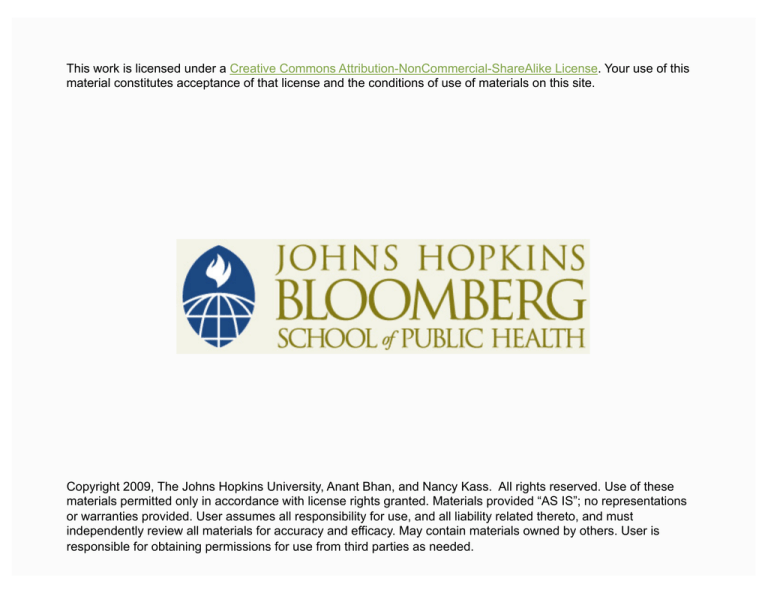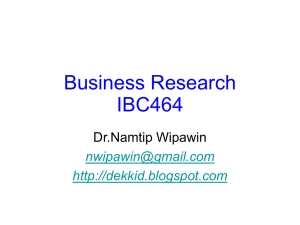
This work is licensed under a Creative Commons Attribution-NonCommercial-ShareAlike License. Your use of this
material constitutes acceptance of that license and the conditions of use of materials on this site.
Copyright 2009, The Johns Hopkins University, Anant Bhan, and Nancy Kass. All rights reserved. Use of these
materials permitted only in accordance with license rights granted. Materials provided “AS IS”; no representations
or warranties provided. User assumes all responsibility for use, and all liability related thereto, and must
independently review all materials for accuracy and efficacy. May contain materials owned by others. User is
responsible for obtaining permissions for use from third parties as needed.
Ethics Committees
Anant Bhan, MBBS, MHSc
Ethical Social and Cultural Program for the Grand
Challenges in Global Health Initiative
Nancy E. Kass, ScD
The Johns Hopkins Berman Institute of Bioethics
Objectives of Session
Understand the role and responsibilities of the ECs in the protection
of the welfare of human research subjects
Understand the basic operations and functions of ECs
3
Section A: What an EC Is and How It Functions
Anant Bhan, MBBS, MHSc
Life of Research Project
5
Definition: Ethics Committee
A committee appointed to consider ethical issues and dedicated to
protecting the rights and well-being of research participants
6
Nomenclature
Ethics review board (ERB)
Research ethics board (REB)
Research ethics committee (REC)
Institutional review board (IRB)
Institutional ethics committee (IEC)
7
Role of the EC—NCESSRH Guidelines
Functions of the EC
- Protection: To contribute to the dignity, rights, safety, and
well-being of all groups and persons related to the concerned
project activity, this would include participants in the research,
community at large, researchers, research community, and
institution
- Advice: Useful resource for commenting on project
- Education: Of project staff
- Analysis and documentation: For self-learning and educating
others
8
Structure of EC
Composition
- Multidisciplinary and multisectorial in composition
- Number of persons: 5/7–12/15
9
Members of EC
Chair
One to two basic medical scientists
One to two clinicians from various institutes
One legal expert or retired judge
One social scientist/representative of NG voluntary agency
One philosopher/ethicist/theologian
One lay person
Member secretary
If required, subject experts could be invited to offer views
10
Specific Members of ECs
Chair should preferably be from outside the institution and not
head of the same institution to maintain the independence of the
committee
Member secretary from same institution should conduct the business
of the committee
11
Functioning of ECs
Described in terms of the following:
- Review procedures
- Decision-making processes
- Documentation requirements
12
Review Procedures
Scientific evaluation should be completed before ethical evaluation
Evaluate possible risks to the subjects with proper justification
Expected benefits
13
Review Procedures
Adequacy of documentation for ensuring privacy, confidentiality and
justice issues: application, budget, supporting documents (including
consent form), etc.
The ethical review should be done through formal meetings and
should not resort to decisions through email or phone
Decisions are preferably arrived at by consensus
14
Steps towards the EC Meeting
1. Prefixed dates for routine EC meetings
2. Submissions made by researchers in keeping with the requirements
of the EC’s SOP
3. Finalizing primary and secondary reviewers
4. The proposals circulated to members giving sufficient time for
review
15
Steps towards the EC Meeting
5. The members undertake the review
6. The meeting of the EC
7. Discussions at the EC
8. Decisions made
9. The process and decisions are documented
10. These decisions and the reasons are communicated to the
researchers
16
Preparatory Phase: Steps 1–4
Step 1. Prefixed dates
- Need to be finalized in advance
- This helps researchers develop, finalize the materials
- Plan in advance
Step 2. Submissions to the EC
- Knowledge of the dates facilitates timely submissions
17
Preparatory Phase: Steps 1–4
Step 3. Primary and secondary reviewers
- The secretariat of the ERB sorts through the proposals, allocates
primary and secondary reviewers for the proposals that need
full review
Step 4. Sending of proposals
- Proposals are mailed to all members
18
The Review Phase: Steps 5–9
Step 5. The review
- The members review the proposal keeping in mind the subjects
(vulnerability, etc.), the process (consent, requirements for
privacy and confidentiality, etc.), the study requirements
(risks/benefits, etc.)
- Seeks and obtains clarifications if necessary
19
The Review Phase: Steps 5–9
Step 6. The EC meeting
- Presided over by the chair
- The members have done their homework!
- Attend meeting and engage in discussion
- If further clarifications needed, ask for the PI to be present
- Discuss and discuss and discuss
20
The Review Phase: Steps 5–9
Step 7. The discussions
- The various members raise concerns regarding aspects of
proposal
- Many of the issues are clarified by within-group discussions
- Usually the guidance from the ICMR guidelines and the various
government regulations are referred to already by specific
members when there are contentious issues
- In case these are not adequate, the members also use other
guidelines and use scholarly journals for additional support for
decisions
21
The Review Phase: Steps 5–9
Step 8. The decision
- Usually all concerns are adjusted into the decision by way of
recommendations to be taken into account before giving
clearance
- In case the requirements are trivial, the member secretary is
authorized to obtain clarifications and give clearance
- In case additional information is needed or the clarifications
need further review, a sub-committee may be appointed or
resubmission recommended
22
The Review Phase: Steps 5–9
Step 8. Documenting the decisions
- The member secretary keeps track of the discussions and
decisions
- Compiles the minutes and has them sent to all members present
for corrections if any
- Once these are returned, s/he prepares the minutes for
approval by chair
23
The Review Phase: Steps 5–9
Step 9. The communication with the researchers
- The MS communicates these decisions to the researchers and
also advises them on what is necessary in case of any
recommendations that call for changes, usually within two
weeks of the meeting
24
Steps in EC Review
25
Decision-Making Process—ICMR Guidelines
Decision making
- EC can reverse its decision on study after receiving information
that will adversely affect risk-benefit ratio
- Discontinuation should be ordered if EC finds that goals of trial
have already been achieved midway or unequivocal results are
obtained
26
Decision-Making Process—ICMR Guidelines
The EC should be cognisant of …
- Any amendment to the protocol from the originally approved
protocol with proper justification
- Serious and unexpected adverse events and remedial steps
taken to tackle them
- Any new information that may influence conduct of the study
27
Decision-Making Process
If necessary the PI may be invited to present the protocol or offer
clarifications
Representatives of interest groups can be invited during
deliberations to offer their viewpoint
Subject experts’ views can be invited, but they should not form a
part of the decision-making process. Their opinions must be
recorded.
28
The Decision Making
Step 10. The decision
- Outright approval (At most, only very minor changes are
suggested. The application contained all necessary
information.)
- Approval with modifications (there is enough information to
judge the study, but clarification or changes are needed)
- Resubmit with more information (there is not enough
information to judge the application appropriately
- Outright disapproval (there is no way the researcher can
ethically do study)
29



